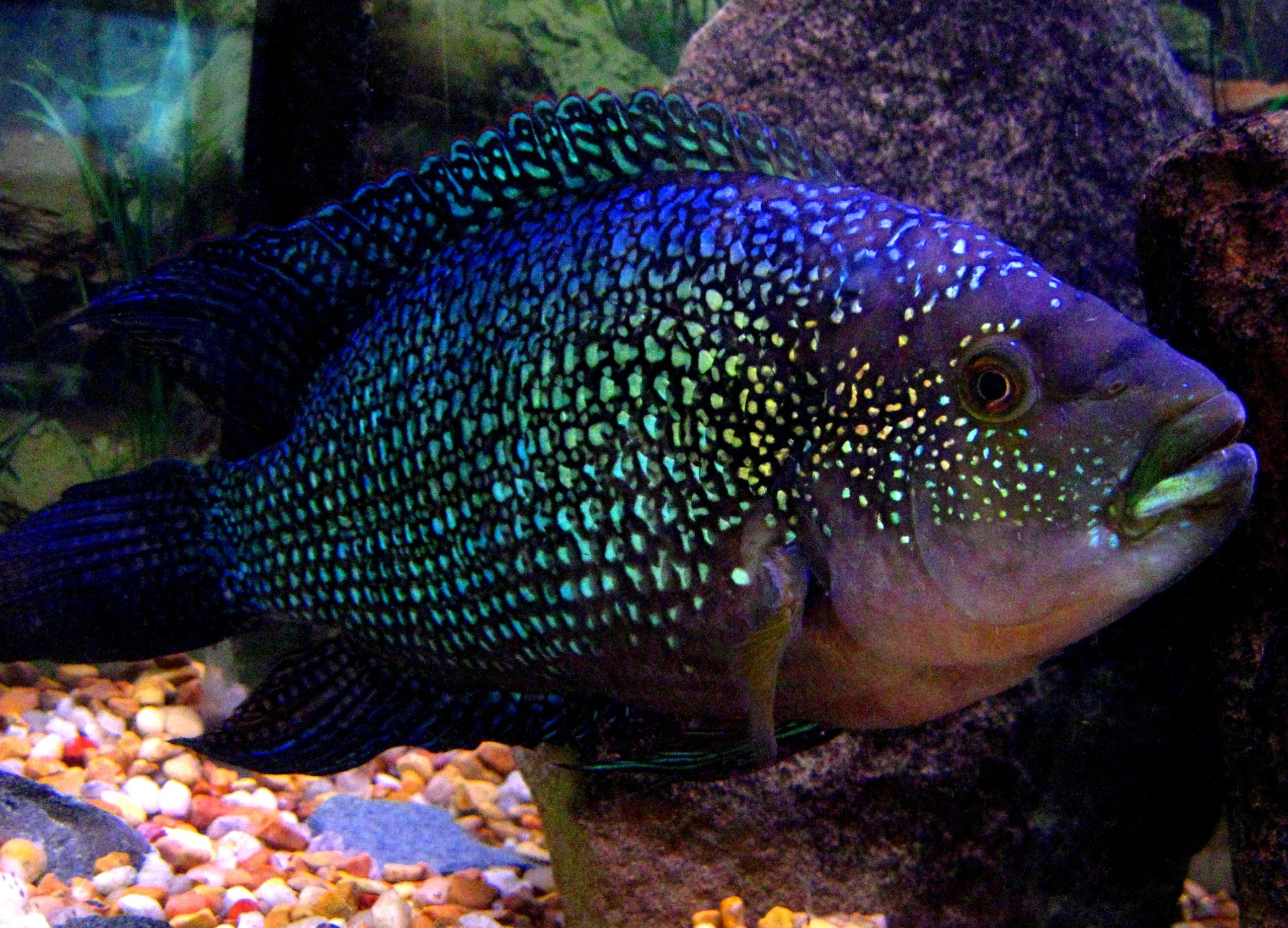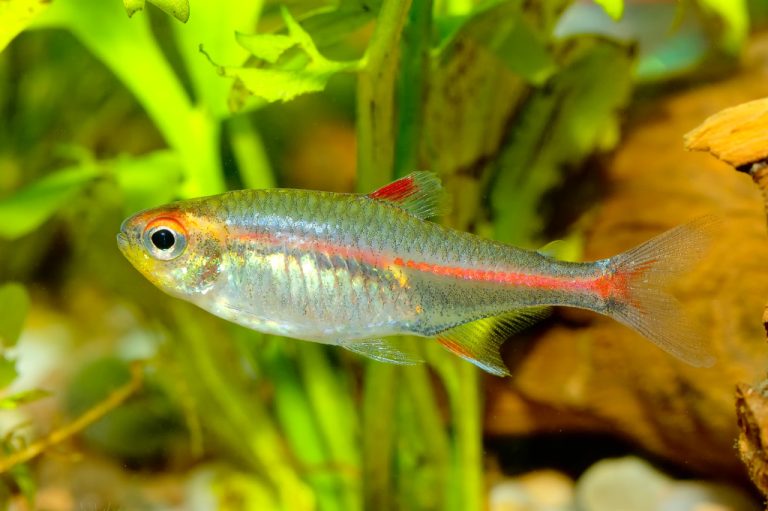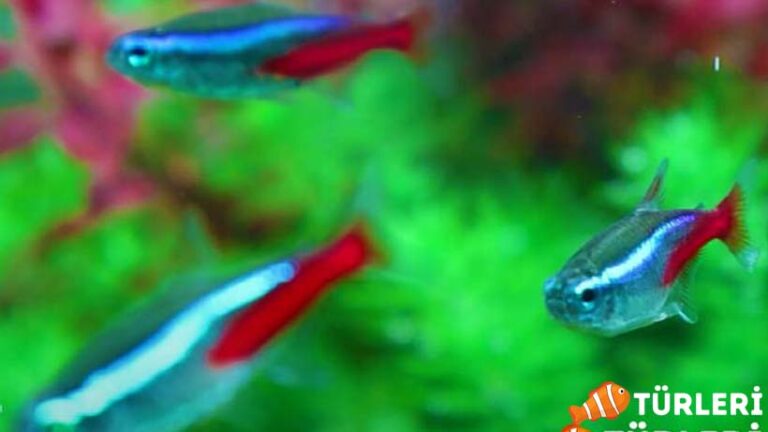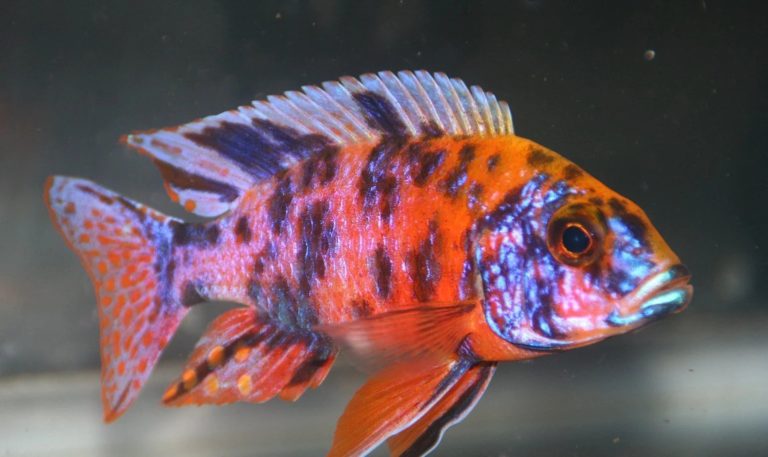Jack Dempsey
The Jack Dempsey, scientifically known as Rocio octofasciata, is a popular freshwater fish species in the aquarium hobby. Named after the famous heavyweight boxing champion Jack Dempsey, this fish is known for its striking appearance and somewhat aggressive nature.
Jack Dempsey Fish Species Summary:
| Scientific Name: | Rocio octofasciata |
| Origin: | Freshwater sources of Central America |
| Diet: | Omnivore (mostly feeds on small fish and invertebrates but may also consume plant matter) |
| Behavior: | Aggressive and territorial |
| Behavior Towards Their Own Species: | Can be very aggressive, especially during breeding seasons. |
| Swimming Zone: | Bottom and middle |
| Water Temperature: | 22 – 28 °C |
| Water Hardness: | 8 – 12 GH |
| pH Level: | 6.5 – 8.0 |
| Minimum Aquarium Volume: | 190 Liters (50 gallons) for a single fish, larger for multiples. |
| Adult Size: | 20 – 25 cm (8-10 inches) |
| Reproduction: | They lay eggs and require flat surfaces for spawning. |
| Lifespan: | 10 – 15 years (with proper care) |
| Care: | Moderate to high, requires regular aquarium cleaning, sufficient hiding spaces, and careful selection of tank mates. |
Appearance and Features
Coloration
The Jack Dempsey fish has a stunning coloration that makes it a popular choice among aquarium enthusiasts. The natural or wild-type coloration of this fish is a dark green or black base color, liberally sprinkled with iridescent flecks of blue, gold, or purple. These flecks give the fish a shimmering appearance, especially when they catch the light. However, there is also a selectively bred variety known as the Electric Blue Jack Dempsey, which is especially sought after for its vibrant, electric blue coloration. This variant still displays the characteristic dark bands and spots of the wild-type Jack Dempsey but has a brighter, more intense blue hue overall.
Size
The Jack Dempsey fish can grow to a significant size, which is an important consideration for anyone thinking about keeping one in their aquarium. In the wild, they can reach up to 10 inches (25 cm) in length, but in captivity, with optimal care and nutrition, they can grow even larger, sometimes reaching up to 12 inches (30 cm) in length. This size means that they require a spacious tank to thrive, and it is essential to plan for their adult size when setting up their habitat.
Sexual Dimorphism
Sexual dimorphism refers to the physical differences between males and females of a species. In the case of the Jack Dempsey fish, males are generally larger and more colorful than females. They usually display brighter, more vibrant colors, and their fins are often longer and more elaborately decorated. Females, on the other hand, are typically smaller and less brightly colored. One of the key identifying features of a female Jack Dempsey is a dark spot on the dorsal fin, which males usually lack. This spot can sometimes be difficult to see, especially on darker colored individuals or when the fish is stressed, so it is not always a reliable indicator of gender. Other signs of a female can include a more rounded body shape and shorter fins, but these can also vary between individual fish. It is often easier to accurately determine the gender of a Jack Dempsey fish once they reach sexual maturity, as the differences between males and females become more pronounced.
Habitat
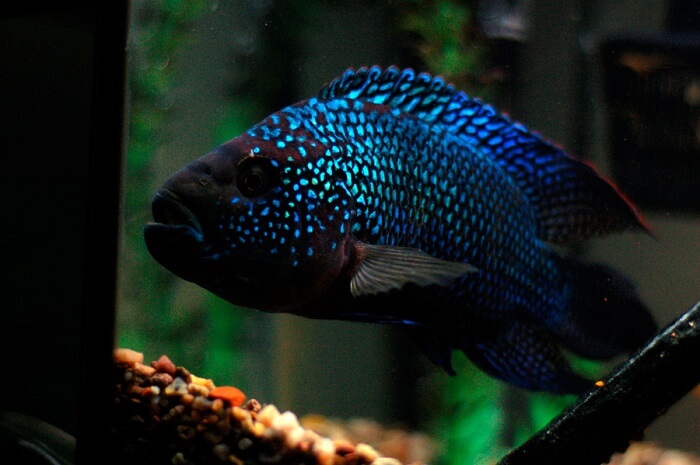
Natural Habitat
The Jack Dempsey fish is native to Central America, specifically found in the slow-moving freshwater rivers and lakes of Mexico, Honduras, and Guatemala. Their natural habitat includes areas with soft, muddy or sandy bottoms, where they can dig and burrow. These environments are usually dense with vegetation, offering plenty of hiding places to escape predators or ambush prey. This type of habitat offers ample cover, which is important for a species that can be as territorial and aggressive as the Jack Dempsey.
Aquarium Setup
Considering their natural habitat, replicating a similar environment in the aquarium is essential for the well-being of the Jack Dempsey fish. A minimum tank size of 55 gallons (208 liters) is recommended for a single Jack Dempsey fish, however, larger is always better as they grow quite large and are territorial.The substrate should be soft and fine, like sand or fine gravel, as they like to dig and burrow. Decorate the tank with plenty of hiding places using large rocks, driftwood, and dense vegetation. Plants like Anubias, Java Fern, or Amazon Sword are good choices as they are hardy and can withstand the digging behavior of the Jack Dempsey.Lighting should be kept dim to mimic their natural environment and to help reduce stress. Additionally, a good quality filtration system is necessary to maintain clean and healthy water as they produce a significant amount of waste.The water parameters should be maintained as follows:
- pH: 6.5-8.0
It’s important to regularly monitor the water quality, as poor water conditions can lead to stress and illness in Jack Dempsey fish. Also, remember to provide enough space and hiding spots, especially if you plan to keep more than one Jack Dempsey or other fish in the tank, to minimize aggression and territorial disputes.
Diet
Omnivorous Nature
Jack Dempseys are omnivorous, meaning they consume both plant and animal matter. However, their natural inclination is towards a more carnivorous diet. In the wild, they would typically feed on smaller fish, insects, and aquatic invertebrates. While they can consume plant matter, animal-based food is essential for their growth and overall health.
Feeding
It is crucial to provide a varied diet to ensure they receive all the necessary nutrients. A high-quality pellet or flake food formulated for carnivorous or omnivorous cichlids can be the staple of their diet. This should be supplemented with a variety of live or frozen foods like bloodworms, brine shrimp, and chopped earthworms. These protein-rich foods will help to promote growth and maintain their vibrant colors. Vegetables like peas and spinach can also be offered occasionally to provide some plant matter in their diet. However, plant-based food should only be a small part of their overall diet as their digestive system is better equipped to handle animal proteins. It is essential to feed them in small amounts multiple times a day rather than a large quantity at once. Overfeeding can lead to obesity and other health problems, as well as pollute the water. A good rule of thumb is to feed them only what they can consume in 2-3 minutes. It’s also important to adjust their diet based on their age, size, and activity level. Younger fish that are still growing may require more protein, while older or less active fish may need less food overall. Remember that a varied diet is key to keeping a Jack Dempsey healthy and happy. Regularly changing up the types of food offered can help prevent nutritional deficiencies and keep the fish interested in its food.
Behavior and Temperament
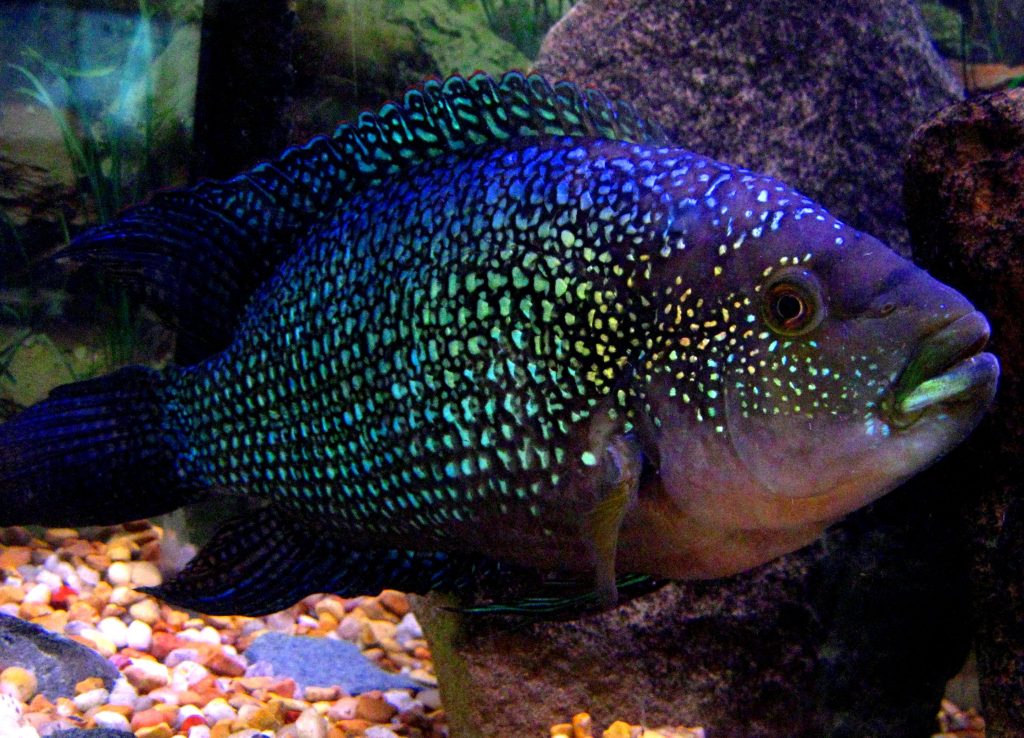
- Aggression: The Jack Dempsey fish is notorious for its aggressive and territorial behavior, especially during breeding seasons. They will often establish a territory within the aquarium and defend it vigorously against intruders. This behavior is more prominent in males, but females can also exhibit territoriality. It is, therefore, recommended to keep them in a species-only tank or with other large, semi-aggressive fish that can hold their own against the Jack Dempsey. Keeping them with smaller, more passive fish may result in the smaller fish being bullied or even killed.
- Compatibility: If you do want to keep Jack Dempseys with other fish, consider large species like Oscars, Firemouth Cichlids, or Convict Cichlids. These species are robust and semi-aggressive, which means they can hold their own against the Jack Dempsey’s territorial behavior. However, be cautious as fights can still occur, especially if the tank is too small or there are not enough hiding places. It is important to provide plenty of hiding spots and ensure the tank is spacious enough to allow for territorial demarcation.
- Social Structure: Jack Dempseys are generally solitary fish, although they will form monogamous pairs during the breeding season. It is advisable to keep them as a single specimen or as a breeding pair in the aquarium. Keeping more than one male in the same tank can lead to fierce battles for territory and dominance.
- Activity Level: They are relatively active fish and will often be seen patrolling their territory or searching for food. However, they also appreciate having plenty of hiding spots where they can retreat if they feel threatened.
Overall, the Jack Dempsey fish is not recommended for beginners due to its aggressive nature and specific care requirements. It is better suited to more experienced aquarists who can provide the necessary care and attention to keep this beautiful but feisty fish happy and healthy.
Breeding
Jack Dempseys are egg layers, and while they have a reputation for being aggressive, they are relatively easy to breed in captivity.
- Breeding Pair: It is best to let the Jack Dempseys choose their own mate. Start by keeping a group of juveniles together and wait for a pair to form naturally. Once a pair has formed, they will usually stay together and may become aggressive towards other fish, so it is advisable to move them to a separate breeding tank.
- Spawning: Once a pair is formed, they will start preparing for spawning. They will clean a flat surface, like a rock or the bottom of the tank, where the female will lay her eggs. The female can lay up to 500-800 eggs at a time. Both parents will guard the eggs and fry aggressively. The male usually guards the perimeter while the female stays closer to the eggs.
- Parental Care: Jack Dempseys exhibit exceptional parental care. Both parents will take turns fanning the eggs with their pectoral fins to provide oxygen and prevent fungus. The eggs will hatch in about 3-4 days, and the fry will be free-swimming in about a week. During this time, the parents will continue to guard the fry and may even carry them in their mouths to move them to a safer location. It is essential to provide plenty of hiding places for the fry to increase their chances of survival.
- Feeding the Fry: Once the fry are free-swimming, they can be fed finely crushed flake food or specially formulated fry food. Baby brine shrimp and microworms are also excellent food options for the fry.
It is important to note that while Jack Dempseys are relatively easy to breed, raising the fry can be challenging due to the aggressive nature of the parents. It may be necessary to remove the parents from the tank once the fry start swimming freely to prevent them from being harmed.
Overall, breeding Jack Dempseys can be a rewarding experience for experienced aquarists. With the right care and attention, you can successfully breed and raise Jack Dempsey fish in your home aquarium.
Water Parameters
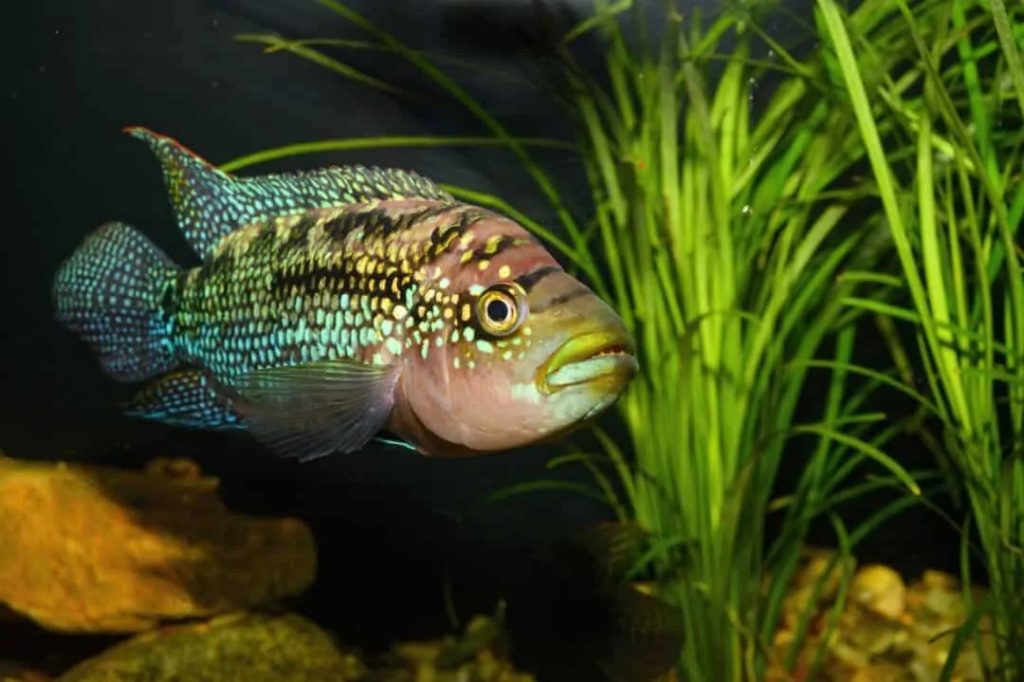
Maintaining the correct water parameters is crucial for the health and well-being of Jack Dempsey fish. These are tropical freshwater fish and thrive in specific water conditions.
- Temperature: Jack Dempseys prefer a water temperature between 75-80°F (24-27°C). It is essential to maintain a stable temperature within this range as sudden fluctuations can cause stress and lead to illness.
- pH: The ideal pH range for Jack Dempseys is between 6.5-8.0. Maintaining a neutral to slightly alkaline pH is important as it mimics their natural habitat.
- Hardness: The water hardness should be between 8-12 dGH. This is the general hardness of the water and is a measure of the calcium and magnesium ions present.
It is important to regularly test the water parameters to ensure they remain within the desired ranges. Any sudden changes in water parameters can lead to stress and potentially fatal health issues. It is also advisable to perform regular water changes to help maintain water quality.
Remember, Jack Dempseys are not recommended for beginners due to their aggressive nature and specific care requirements. It is always best to thoroughly research any species before adding it to your aquarium and to regularly monitor the health and behavior of all your fish. Keeping a close eye on your fish will help you quickly identify and address any potential issues before they become serious problems.

